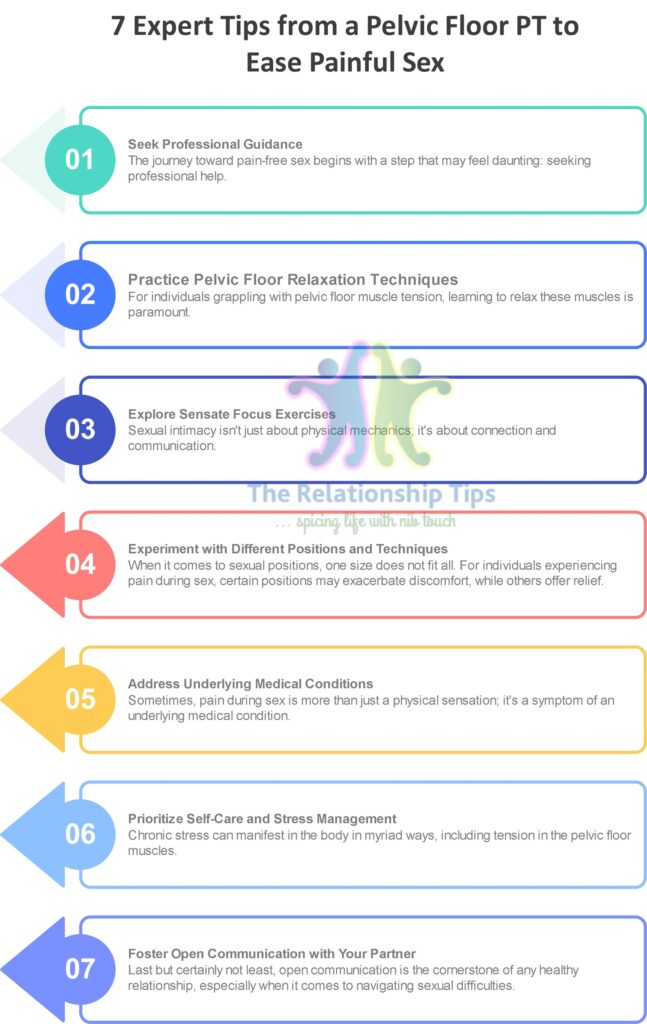Sexual intimacy is a profound expression of human connection, a dance of vulnerability and pleasure shared between partners. Yet, for many individuals, this intimate act is marred by the shadow of pain, casting a pall over what should be a source of joy and fulfillment. Whether it’s a fleeting discomfort or a chronic ache, pain during sex can disrupt not only physical pleasure but also emotional intimacy and relationship harmony.
However, there is hope on the horizon. Guided by the expertise of pelvic floor physical therapists (PTs), individuals grappling with painful sex can embark on a journey toward relief and restoration.
In this comprehensive guide, we’ll explore seven expert-backed tips from a pelvic floor PT to help you unlock comfort and enjoyment in your sexual experiences. From understanding pelvic floor dysfunction to fostering open communication with your partner, each tip offers a beacon of hope for those seeking to reclaim pleasure and intimacy in their intimate lives. So, let’s embark on this journey together, illuminating the path toward a future free from pain and filled with the boundless possibilities of connection and pleasure.
In This Article
- 1 Understanding Pelvic Floor Dysfunction
- 1.1 1. Seek Professional Guidance
- 1.2 2. Practice Pelvic Floor Relaxation Techniques
- 1.3 3. Explore Sensate Focus Exercises
- 1.4 4. Experiment with Different Positions and Techniques
- 1.5 5. Address Underlying Medical Conditions
- 1.6 6. Prioritize Self-Care and Stress Management
- 1.7 7. Foster Open Communication with Your Partner
- 1.8 Infographic: 7 Expert Tips from a Pelvic Floor PT to Ease Painful Sex
- 2 Frequently Asked Questions About Pelvic Floor PT to Ease Painful Sex
- 3 What causes pain during sex?
- 4 How common is painful sex, and who does it affect?
- 5 When should I seek help for pain during sex?
- 6 Can painful sex be treated, and is it possible to enjoy sex again?
Understanding Pelvic Floor Dysfunction
Before diving into the solutions, it’s essential to grasp the intricate web of muscles and tissues that make up the pelvic floor. Picture a hammock-like structure supporting the bladder, uterus, and rectum. This network of muscles plays a crucial role not only in maintaining continence but also in sexual function. Dysfunction in these muscles, whether it’s tightness, weakness, or spasms, can lead to a variety of symptoms, including pain during intercourse.
1. Seek Professional Guidance
The journey toward pain-free sex begins with a step that may feel daunting: seeking professional help. Enter the pelvic floor physical therapist. Trained to assess and treat pelvic floor dysfunction, these specialized therapists conduct thorough evaluations to pinpoint the root causes of pain. From there, they develop personalized treatment plans that may include exercises, manual therapy, and education about sexual anatomy and function.
2. Practice Pelvic Floor Relaxation Techniques
For individuals grappling with pelvic floor muscle tension, learning to relax these muscles is paramount. Enter pelvic floor relaxation techniques. Picture yourself lying on your back, hands resting gently on your abdomen. As you inhale deeply, feel your belly rise like a balloon, allowing your pelvic floor to gently release and soften. These techniques, such as diaphragmatic breathing and pelvic floor drops, can help individuals regain control over their pelvic floor muscles, reducing pain and promoting relaxation.
3. Explore Sensate Focus Exercises
Sexual intimacy isn’t just about physical mechanics; it’s about connection and communication. Sensate focus exercises, a cornerstone of psychosexual therapy, provide a roadmap for couples seeking to rekindle intimacy amidst pain. From feather-light touches to lingering caresses, these exercises invite partners to explore each other’s bodies with curiosity and compassion, fostering trust and deepening emotional connection.
4. Experiment with Different Positions and Techniques
When it comes to sexual positions, one size does not fit all. For individuals experiencing pain during sex, certain positions may exacerbate discomfort, while others offer relief. Consider the spooning position, where partners lie side by side, or the woman-on-top position, where the receiving partner can control the depth and pace of penetration. Additionally, incorporating plenty of water-based lubricant can reduce friction and enhance comfort during intercourse.
5. Address Underlying Medical Conditions
Sometimes, pain during sex is more than just a physical sensation; it’s a symptom of an underlying medical condition. Conditions such as endometriosis, vulvodynia, and pelvic inflammatory disease can wreak havoc on pelvic health, leading to pain and discomfort during intercourse. By working closely with healthcare providers to diagnose and manage these conditions, individuals can take proactive steps toward reclaiming their sexual well-being.
6. Prioritize Self-Care and Stress Management
Chronic stress can manifest in the body in myriad ways, including tension in the pelvic floor muscles. That’s why prioritizing self-care and stress management is crucial for individuals seeking relief from painful sex. From yoga and meditation to journaling and spending time in nature, finding activities that nourish the mind, body, and soul can help reduce overall tension and promote pelvic floor health.
7. Foster Open Communication with Your Partner

Last but certainly not least, open communication is the cornerstone of any healthy relationship, especially when it comes to navigating sexual difficulties. By creating a safe space to discuss desires, boundaries, and concerns, partners can work together to find solutions and strengthen their connection. Remember, intimacy is not just about physical pleasure; it’s about vulnerability, trust, and mutual understanding.
Infographic: 7 Expert Tips from a Pelvic Floor PT to Ease Painful Sex

Frequently Asked Questions About Pelvic Floor PT to Ease Painful Sex
What causes pain during sex?
Pain during sex can stem from various factors, including pelvic floor dysfunction, such as muscle tension or weakness, medical conditions like endometriosis or vulvodynia, psychological factors like stress or anxiety, insufficient lubrication, or trauma. Identifying the underlying cause often requires a comprehensive evaluation by a healthcare provider, such as a pelvic floor physical therapist or gynecologist.
How common is painful sex, and who does it affect?
Painful sex, also known as dyspareunia, is more common than one might think. While it can affect individuals of any gender, it is particularly prevalent among cisgender women. Studies suggest that up to 75% of women experience pain during sex at some point in their lives. However, it’s essential to recognize that painful sex can affect people of all genders and sexual orientations.
When should I seek help for pain during sex?
It’s essential to seek help for pain during sex if it’s persistent, severe, or significantly impacts your quality of life and relationships. Consulting with a healthcare provider, such as a pelvic floor physical therapist or gynecologist, can help identify the underlying cause and develop a personalized treatment plan. Additionally, seeking support from a therapist or counselor can be beneficial, especially if psychological factors contribute to the pain.
Can painful sex be treated, and is it possible to enjoy sex again?
Yes, painful sex can often be treated successfully with the right approach. Treatment may involve a combination of pelvic floor physical therapy, medical interventions, psychological support, and lifestyle modifications. By addressing underlying factors contributing to the pain and implementing targeted interventions, many individuals can experience significant improvement in their symptoms and regain enjoyment of sex. It’s essential to be patient and persistent in seeking help and exploring different treatment options until you find what works best for you. Remember, you deserve to experience pleasure and intimacy in your sexual relationships, and help is available to support you on your journey towards a fulfilling and pain-free sex life.
Conclusion
In the realm of sexual intimacy, pain should never be a barrier to connection and pleasure. Through the guidance of pelvic floor physical therapists and the implementation of expert-backed strategies, individuals can navigate the challenges of painful sex with resilience and hope. From practicing pelvic floor relaxation techniques to fostering open communication with partners, each tip in this guide offers a pathway toward relief and restoration. Remember, you are not alone on this journey. With the support of healthcare professionals and understanding partners, you can reclaim pleasure and intimacy in your intimate relationships.
As you move forward, may you find comfort in knowing that a future free from pain is not just a dream but a tangible reality within your grasp. So, embrace this journey with courage and determination, knowing that brighter days filled with connection, pleasure, and fulfillment await on the horizon.





